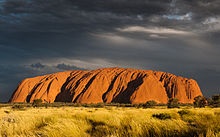|
|
| |
|
|
| |
|
|
|
|
| |
 |
| Uluru (Ayers Rock)
is a large sandstone formation in Northern
Territory, Australia. |
Petrology
Petrology (from the Ancient Greek: πέτρος, romanized:
pétros, lit. 'rock' and λόγος, lógos) is the branch of
geology that studies rocks and the conditions under
which they form. Petrology has three subdivisions:
igneous, metamorphic, and sedimentary petrology. Igneous
and metamorphic petrology are commonly taught together
because they both contain heavy use of chemistry,
chemical methods, and phase diagrams. Sedimentary
petrology is, on the other hand, commonly taught
together with stratigraphy because it deals with the
processes that form sedimentary rock. |
|
Background
Lithology was once approximately synonymous with
petrography, but in current usage, lithology focuses on
macroscopic hand-sample or outcrop-scale description of
rocks while petrography is the speciality that deals
with microscopic details.
In the petroleum industry, lithology, or more
specifically mud logging, is the graphic representation
of geological formations being drilled through, and
drawn on a log called a mud log. As the cuttings are
circulated out of the borehole they are sampled,
examined (typically under a 10× microscope) and tested
chemically when needed. |
|
Methodology
Petrology utilizes the fields of mineralogy,
petrography, optical mineralogy, and chemical analysis
to describe the composition and texture of rocks.
Petrologists also include the principles of geochemistry
and geophysics through the study of geochemical trends
and cycles and the use of thermodynamic data and
experiments in order to better understand the origins of
rocks. |
|
Branches
There are three branches of petrology, corresponding to
the three types of rocks: igneous, metamorphic, and
sedimentary, and another dealing with experimental
techniques: |
- Igneous petrology focuses on the
composition and texture of igneous rocks (rocks such
as granite or basalt which have crystallized from
molten rock or magma). Igneous rocks include
volcanic and plutonic rocks.
- Sedimentary petrology focuses on
the composition and texture of sedimentary rocks
(rocks such as sandstone, shale, or limestone which
consist of pieces or particles derived from other
rocks or biological or chemical deposits, and are
usually bound together in a matrix of finer
material).
- Metamorphic petrology focuses on
the composition and texture of metamorphic rocks
(rocks such as slate, marble, gneiss, or schist
which started out as sedimentary or igneous rocks
but which have undergone chemical, mineralogical or
textural changes due to extremes of pressure,
temperature or both)
- Experimental petrology employs
high-pressure, high-temperature apparatus to
investigate the geochemistry and phase relations of
natural or synthetic materials at elevated pressures
and temperatures. Experiments are particularly
useful for investigating rocks of the lower crust
and upper mantle that rarely survive the journey to
the surface in pristine condition. They are also one
of the prime sources of information about completely
inaccessible rocks such as those in the Earth's
lower mantle and in the mantles of the other
terrestrial planets and the Moon. The work of
experimental petrologists has laid a foundation on
which modern understanding of igneous and
metamorphic processes has been built.
|
|
|
|
|
|
|
|
|
|
|
|
|
|
|
|
|
|
|
Search Fun Easy English |
|
|
|
|
|
|
|
|
|
|
|
|
|
|
|
About
Contact
Copyright
Resources
Site Map |